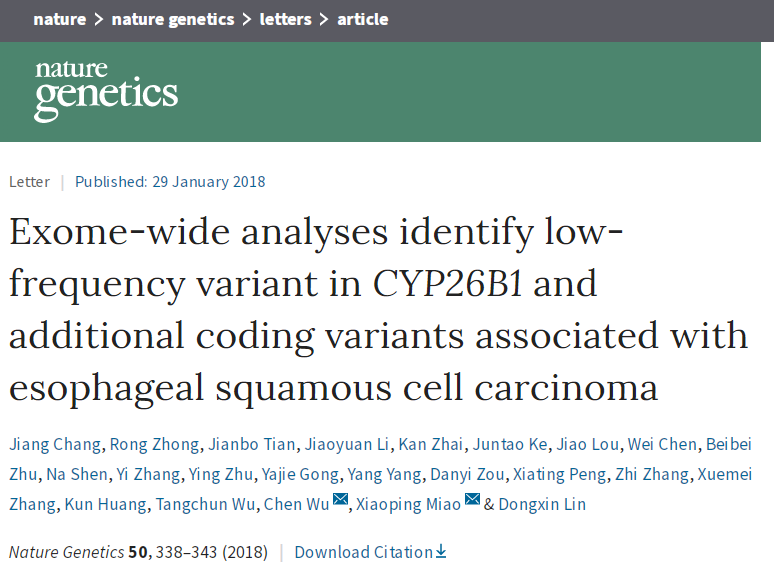Wuhan, China — Esophageal squamous cell carcinoma (ESCC) is the leading cancer in China with half of the world’s new cases occur in our country each year. ESCC is an extremely malignant cancer with a very poor prognosis. Therefore, it is a major public health problem that seriously threatens the lives of people in our country.
In this study, Prof. Miao Xiaoping of the School of Public Health, performed a large-scale association analysis with 10,716 ESCC cases and 12,637 controls, and conducted an in-depth functional mechanism analysis. They identified 6 ESCC susceptibility loci in the Chinese population, including one in the retinoic acid metabolism enzyme gene, CYP26B1. They also revealed the important role of all-trans retinoic acid metabolism in the development of ESCC and provided new insights into the prevention and treatment of this cancer. This study was published online in January 30, 2018 in Nature Genetics (IF: 27.959).
In recent years, scientists represented by Academician Lin Dongxin of Peking Union Medical College have revealed a series of susceptibility genes for ESCC through the Genome-wide Association Study (GWAS). However, most of the identified variants were common ones located in non-coding regions. Genetic variants in the coding regions, with less frequent in the population, may also play an important role in the development of ESCC. It is a major challenge for molecular epidemiologist to identify these genetic susceptibility variants.
In this study, Prof. Miao Xiaoping’s group performed an exome-wide interrogation of 3,714 individuals with ESCC and 3,880 controls for low-frequency susceptibility loci with two independent replication samples including 7,002 cases and 8,757 controls. They found six novel susceptibility loci in CCHCR1, TCN2, TNXB, LTA, CYP26B1 and FASN (P = 7.77×10-24 to P = 1.49×10-11) and three low-frequency variants had relatively high effect size (odds ratio being 1.67,1.82 and 1.67 for variants in TCN2, CYP26B1 and FASN). Further analysis showed that genetic viariant in the retinoic acid-metabolizing enzyme CYP26B1 exhibits significant gene-environmental interactions with smoking and excessive drinking. Individuals with risk genotypes and long-term smoking or drinking are at three times higher risk of ESCC than individuals with protective genotypes.
How does this susceptibility gene affect the susceptibility of ESCC? Prof. Miao’s group then carried out a series of functional studies on the genetic variant of the retinoic acid metabolism enzyme gene CYP26B1. Vitamin A is metabolized to all-trans retinoic acid in the human body. The latter participates in many important pathways including immune activation and is an important tumor suppressor. The genetic variant of CYP26B1 found in this study can significantly accelerate the metabolism of all-trans retinoic acid, and rapidly convert it into the inactive hydroxyretinoic acid, reducing its anti-cancer effect. It was confirmed that individuals carrying CYP26B1 fast-metabolizing genotype had significantly lower trans-retinoic acid than individuals carrying wild genotypes. If such people had a long-term smoking or drinking, they will be more likely to get ESCC. This study provides new insights into the molecular epidemiology study. It reveals for the first time that abnormal retinoic acid metabolism is closely related to the occurrence of ESCC in the Chinese population and has great scientific value and public health significance.
Prof. Miao Xiaoping from Huazhong University of Science and Technology and Prof. Wu Chen from Peking Union Medical College are the co-corresponding authors of the paper. Dr. Chang Jiang, Prof. Zhong Rong, Ph.D. candidate Tian Jianbo and Li Jiaoyuan are the co-first authors of the paper. Academician Lin Dongxin from the Peking Union Medical College and Prof. Wu Tangchun from the Huazhong University of Science and Technology gave valuable guidance to the study. The work was supported by the National Key Research and Development Plan Program, National Excellent Youth Science Fund of NSFC, National Program for Support of Top-notch Young Professionals, and the the Youth Innovation Team Project of Huazhong University of Science and Technology.
Chinese News Link: http://gwxy.tjmu.edu.cn/info/1067/2129.htm
For more details of the paper, please visit: https://www.nature.com/articles/s41588-018-0045-8


